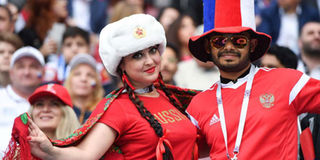Russia World Cup Notebook - Day 2

Russia fans pose as they wait for the start of the Russia 2018 World Cup Group A match between Russia and Saudi Arabia at the Luzhniki Stadium in Moscow on June 14, 2018. PHOTO | PATRIK STOLLARZ | AFP
Russia: A country in two continents
*****
Russia, the world’s largest countries, by size, covers some 17.1 million square kilometres. According to the World Bank, Russia has a population of 144.3 million people.
The country lies in two continents – Asia and Europe. Some 75 per cent of Russia is in Asia, while the rest is in Europe. The larger part of the country that lies in Asia makes up the Siberia, the severely cold and uninhabited region of the country.
The Fifa World Cup is being held in European Russia. Socially and culturally, the Russian Federation is more aligned to Europe. Russia is is part of numerous European organisations.
Hey, we are from European Russia...
*****
Seventy-five per cent of Russia lies in Asia, but almost 77 per cent of the country’s population lives in European Russia.
Standing at the Red Square in the heart of Moscow, most people I interacted with here immediately identify with the European Russia, the more prosperous but smaller half the country. Russia is a member of the Council of Europe, Organization for Security and Co-operation in Europe, and the Eurasian Economic Union.
So far, I’m yet to meet a Russian from the Asian part of the country. I hope to do so before my tour of duty here ends.
Of Siberia, gulags and punishment
*****
To send someone to Siberia means to punish someone by not talking to them, to cut off, to leave out in the cold. This phrase has its origins in Russia. In 19th century Russia, criminals and political radicals were often sent to labour camps, mostly located in Siberia (the severely cold and uninhabited region of the country) as punishment. The Soviets also used exile as punishment. In the early days of the Soviet Union, there were concentration camps known as GULAG, an acronym for the Russian phrase, ‘Main Administration of Corrective Labour Camps.’ Most of the gulag camps were in Siberia and the Far East.
Museum displays horror of dark past
*****
Moscow is home to Gulag History Museum. It details the dark history of Russia. An estimated nine out of every 10 prisoners died in the gulags, including many artists and intellectuals. After Stalin died in 1953, Nikita Khrushchev came to power in the Soviet Union and publicly condemned the atrocities committed in the gulag. In 1962, Khrushchev allowed writer Aleksandr Solzhenitsyn, who spent eight years in the camps, to publish his novel, One Day in the Life of Ivan Denisovich, about a typical day in the gulag. Solzhenitsyn’s novel won the Nobel Prize and brought worldwide attention to the Soviet labour camps.





